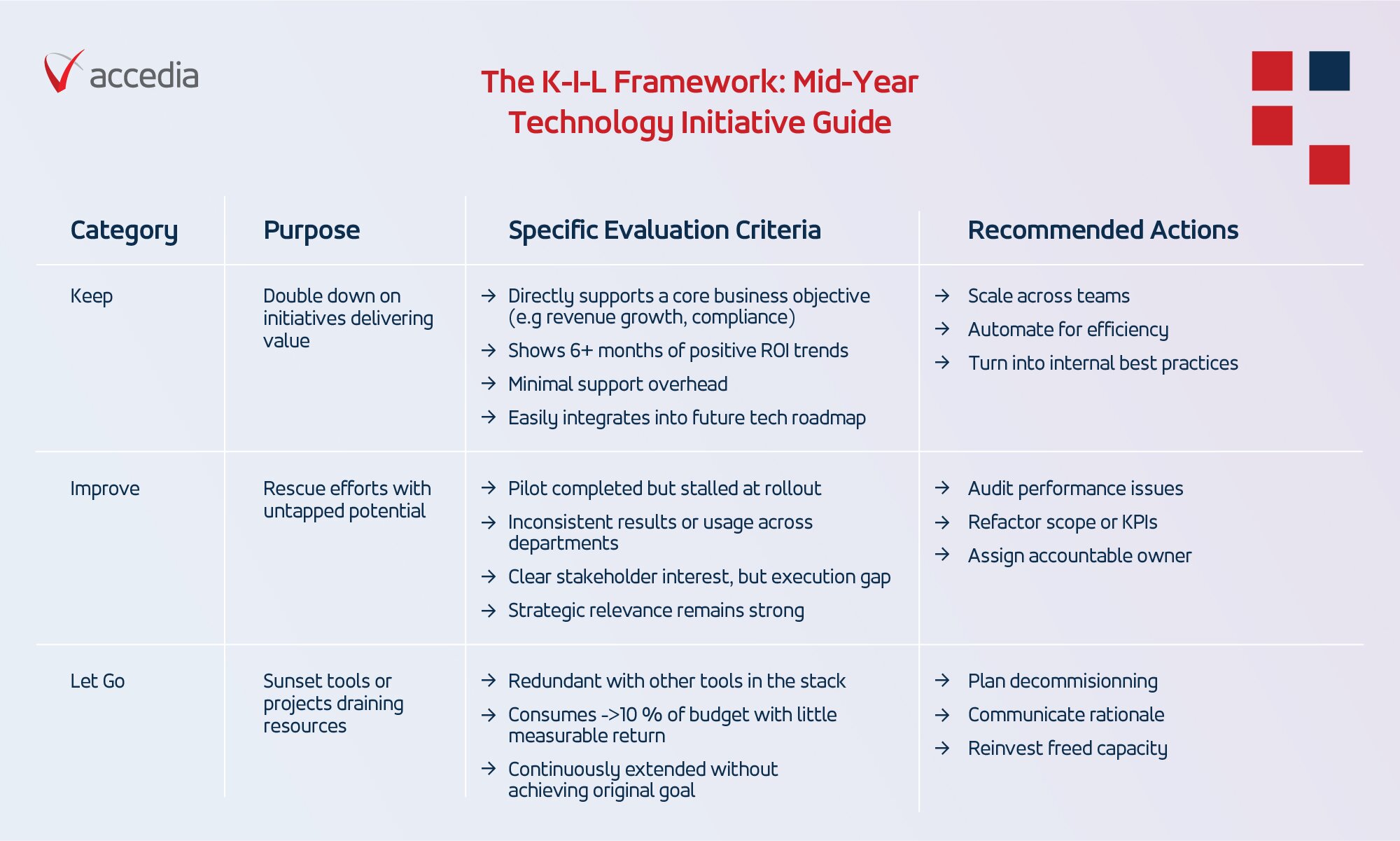Mid-Year Technology Audit: Your Winning Framework to Reclaim ROI
10.07.2025
In the blink of an eye, we’re suddenly halfway through the year. If you're running a team at a small or mid-sized company, you know this feeling: a dozen initiatives in motion, a few that haven’t quite landed, and that growing sense that some things just aren’t delivering the expected results.
Now’s your moment to pause and rethink the situation. Not with a big overhaul, but with a few smart moves that can sharpen your focus and change how the rest of the year plays out. And why now? Because the stakes are high, in 2024 alone, enterprises are set to lose over $104 million due to underused technology and inefficient workflows. For smaller companies, the pressure to get it right with leaner resources is even greater.
Hence, this guide offers a practical technology strategy framework designed to help you step back, reassess, and redirect your team’s energy to where it counts most.
The Keep-Improve-Let Go Technology Audit Framework: A Mid-Year Evaluation Tool
You probably already have a gut feeling about what’s working and what’s not. However, when it comes to acting on those instincts, it helps to have a structure. That’s where the Keep – Improve – Let Go technology audit framework comes in. It gives you a clear way to assess ongoing systems, workflows, or pilot projects - and turn those insights into better IT investment decisions. Instead of falling into vague debates about “business value,” the framework relies on tangible signals: is there momentum, clear ownership, measurable return? Each category leads to a focused next step - scale what works, fix what’s promising, and free your team from what’s slowing them down.

Keep – Double Down on What’s Creating Real Value
If something’s being used daily, by more than one team, and clearly driving results, it’s not just working, it’s winning. The key is to scale it without letting complexity creep in.
Start by validating the value. Ask sharper questions. Is it helping multiple functions? Is it embedded in their workflows? These signals tell you it’s worth doubling down.
At that point, treat it like an internal product. Define a backlog, assign a support model, and map out a lightweight roadmap so it can grow alongside adoption. Promote it internally as a solution that teams can rely on.
A good example from our side is the Accedia Voice Assistant (AVA), originally developed through the Accedia Innovation Development Center initiative. What started as an idea quickly turned into a tool that multiple teams now rely on daily. AVA understands Bulgarian, responds naturally to voice commands, and helps with practical tasks, like detecting available parking spaces by analyzing real-time camera feeds. As adoption grew, we refined the interface, prioritized useful features, and integrated AVA into our daily office routine.
Once you’ve scaled the basics, focus on lowering the barrier to entry. Simplify usage with ready-to-go settings, intuitive naming, and built-in links to familiar tools. From there, establish a steady review rhythm. Spot where usage drops off, which features are ignored, and where confusion tends to creep in. One smart move: bring in feedback from teams outside the original creators. It adds a fresh perspective and often highlights issues or strengths that weren’t obvious before.
Improve - Unlock the Untapped Value
In the middle of the year, it’s worth taking a closer look at the things that aren’t delivering the expected results. Maybe people are avoiding a certain tool or workflow, finding workarounds, or duplicating effort. That usually means there’s friction somewhere, and very often, the fix isn’t huge.
In such cases, I’ve noticed what usually helps is narrowing the focus. We pick only one high-impact scenario where this specific tool or process should be helping and make that the priority. When people know exactly what a system is meant to do, and it does that well, engagement tends to follow. That also means the scope of measurement needs to be more specific as well. Choose one clear outcome tied to that scenario and use it to guide your next steps. This focused approach also often leads to a higher return on technology investments, especially when resources are tight.
Ownership matters, too. If progress has stalled, it might be time to reassign it. Sometimes the person who kicked things off just isn’t the right fit to carry it forward, and that’s okay. Hand it over to someone with the headspace, curiosity, and technical know-how to see what’s missing and make it better. A fresh set of skills can uncover opportunities the original team couldn’t see.
Let Go – Free Up Time, Budget, and Headspace
Let’s be honest: not everything deserves the attention we are giving it. It’s about time to make peace with that. One of the most revealing parts of any technology audit is spotting the tools or workflows that no longer serve your goals. Holding onto them only clutters priorities, drains team energy, and doesn’t allow for effective IT budget optimization. In fact, studies show that nearly two-thirds of employees feel burned out during ongoing digital transformation efforts. Some of that pressure surely comes from constantly trying to maintain what should have already been retired.
I’m not saying you need to remove everything overnight. Start small. Focus on low-risk removals, such as tools or systems that haven’t been used in over 60 days and have no active dependencies – for example, low-code tools, old CRMs, or unused BI dashboards. Next, run a quick redundancy check. How many systems are tracking the same metrics or supporting identical workflows? The aim isn’t to trim just for the sake of it, but to simplify where it counts. When teams rely on fewer, more purposeful solutions, it frees up energy for initiatives that feel more meaningful.
And then there’s the tough part: legacy decisions. These are the systems you’ve kept around “for one client,” or because “we’ve always used it,” or simply because it’s already been paid for. If something demands constant maintenance or no longer aligns with your roadmap, it’s time to take a clean break.

One company that embraced this approach is IBM. After years of investing heavily in hardware, it became clear the ROI was no longer there. In the 1990s, the company made the bold move to divest from its hardware divisions - including chips and printers - and reoriented toward software and IT services. This strategic shift eventually led IBM to reclaim market relevance and build a brand now worth over $87 billion.
Of course, this doesn’t mean making drastic changes like this overnight. But letting go of what no longer serves you can unlock unexpected benefits and free up valuable time. That leads me to my final tip: make the most of the space you create. Reinvest it with intention. That extra capacity can power a pilot initiative, support a training sprint, or give your team the breathing room they’ve been missing. When you show not just what you’ve stopped, but what it enables next, you transform cleanup into meaningful progress.
Bonus: Quick Mid-Year Metrics Check You Can Do Right Now
One thing I consider very beneficial and simple is to do a quick mid-year metrics check. Are they still helping you make better decisions? Review your top three - if none have influenced a decision in the past 30 days, move them to a secondary dashboard. They may still be useful, just not urgent.
Additionally, check with team leaders: is at least one tracked metric clearly tied to a business goal or customer priority? If not, drop or rethink it. For every metric you keep, write a one-liner: “We track [X] because it tells us [Y], which helps us decide [Z].” Can’t fill in the blanks? It’s a clear sign the metric isn’t supporting effective IT performance evaluation and should be reconsidered.
Conclusion
The second half of the year is your chance to get intentional about where your team’s time, tools, and attention go. A simple technology audit helps you move beyond gut feelings and make confident decisions: what to scale, what to fix, and what to retire. It gives structure to mid-year cleanups, cuts back on unnecessary complexity, and makes space for real progress.
The year is half-gone – now is the time to step back, reassess, and steer your digital transformation strategy in the direction that will bring the most results. Learn how Accedia can help you in that journey.